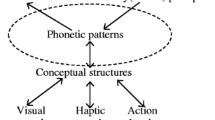Abstract
This paper discusses the methodology and tools applied in the Parallel Grammar project (ParGram) to support consistency and parallelism of linguistic representations across multilingual Lexical Functional Grammar (lfg) grammars. A particular issue is that the grammars in the ParGram project are developed at different international sites. The approach that was established over several years relies on (i) a technical tool for checking adherence to the best-practice feature declaration for linguistic representations, (ii) the coordinated, systematic use of templates for expressing generalizations across lexicon entries and grammar rules, and (iii) a grammar code reviewing committee in which extensions to the existing representations are critically discussed.
Similar content being viewed by others
References
Bender E., Flickinger D., Oepen S. (2002) The Grammar Matrix: An Open-source Starter-kit for the Rapid Development of Cross-linguistically Consistent Broad-coverage Precision Grammars In Proceedings of the Workshop on Grammar Engineering and Evaluation, pp. 8–14. COLING 2002 workshop.
Butt M., Dyvik H., King T.H., Masuichi H., Rohrer C. (2002) The Parallel Grammar Project. In COLING 2002: Workshop on Grammar Engineering and Evaluation, pp. 1–7.
M. Butt T.H. King M.-E. Niño F. Segond (1999) A Grammar Writer’s Cookbook CSLI Publications Stanford
Butt M., Niño M.-E., Segond F. (1996) Multilingual Processing of Auxiliaries in LFG. In Gibbon D. (ed.), Natural Language Processing and Speech Technology: Results of the 3rd KONVENS Conference. pp. 111–122.
A. Copestake (2002) Implementing Typed Feature Structure Grammars CSLI Publications Stanford, CA
M. Dalrymple (2001) Lexical Functional Grammar, Vol. 34 of Syntax and Semantics Academic Press New York
M. Dalrymple R.M. Kaplan (2000) ArticleTitleFeature Indeterminacy and Feature Resolution Language 76 IssueID4 759–798 Occurrence Handle10.2307/417199
Eckle J., Heid U. (1996) Extracting Raw Material for a German Subcategorization Lexicon from Newspaper Text. In Proceedings of the 4th International Conference on Computational Lexicography, COMPLEX’96, Budapest Hungary 1996.
Flickinger D., Bender E. (2003) Compositional Semantics in a Multilingual Grammar Resource. In ESSLLI 2003 Workshop on Ideas and Strategies for Multilingual Grammar Development. This volume.
Frank A. (1999) From Parallel Grammar Development towards Machine Translation. In Proceedings of MT Summit VII, pp. 134–142.
A. Frank T.H. King J. Kuhn J.T. Maxwell (2001) Optimality Theory Style Constraint Ranking in Large-scale LFG Grammars P. Sells (Eds) Formal and Empirical Issues in Optimality Theoretic Syntax CSLI Publications Stanford, California 367–397
R. Hudson (1995) ArticleTitleDoes English really have case? Journal of Linguistics 31 375–392 Occurrence Handle10.1017/S0022226700015644
Kaplan R.M., King T.H., Maxwell III J.T. (2002) The Parallel Grammar Project. In COLING 2002: Workshop on Grammar Engineering and Evaluation, pp. 29–35.
R.M. Kaplan P. Newman (1997) Lexical Resource Reconciliation in the Xerox Linguistic Environment D. Estival A. Lavelli K. Netter F. Pianesi (Eds) Computational Environments for Grammar Development and Linguistic Engineering, Proceedings of a Workshop Sponsored by the Association for Computational Linguistics Spain Madrid 54–61
R.M. Kaplan J. Bresnan (1982) Lexical-Functional Grammar: A Formal System for Grammatical Representation J. Bresnan (Eds) The Mental Representation of Grammatical Relations MIT Press Cambridge 173–281
Kim R., Dalrymple M., Kaplan R.M, King T.H., Masuichi H., Ohkuma T. (2003) Multilingual Grammar Development via Grammar Porting. In ESSLLI 2003 Workshop on Ideas and Strategies for Multilingual Grammar Development.
Kuhn J., Eckle J., Rohrer C. (1998) Lexicon Acquisition with and for Symbolic NLP-Systems – A Bootstrapping Approach. In Proceedings of the First International Conference on Language Resources and Evaluation (LREC98). Granada, Spain, pp. 89–95.
J.T. Maxwell SuffixIII R.M. Kaplan (1993) ArticleTitleThe Interface between Phrasal and Functional Constraints Computational Linguistics 19 571–589
C. Pollard I. Sag (1994) Head-Driven Phrase Structure Grammar, Studies in Contemporary Linguistics University of Chicago Press Chicago
A. Przepiórkowski (2001) ARG-ST on phrases: Evidence from Polish D. Flickinger A. Kathol (Eds) Proceedings of the 7th International Conference on Head-Driven Phrase Structure Grammar CSLI Publications Stanford CA 267–284
Riezler S., King T.H., Kaplan R.M., Crouch R., Maxwell III J.T., Johnson M. (2002) Parsing the Wall Street Journal Using a Lexical-Functional Grammar and Discriminative Estimation Techniques. In Proceedings of the ACL.
W. Wahlster (Eds) (2000) Verbmobil: Foundations of Speech-to-Speech Translation Springer Heidelberg, Germany
Author information
Authors and Affiliations
About this article
Cite this article
King, T.H., Forst, M., Kuhn, J. et al. The Feature Space in Parallel Grammar Writing. Res Lang Comput 3, 139–163 (2005). https://doi.org/10.1007/s11168-005-1295-z
Issue Date:
DOI: https://doi.org/10.1007/s11168-005-1295-z




